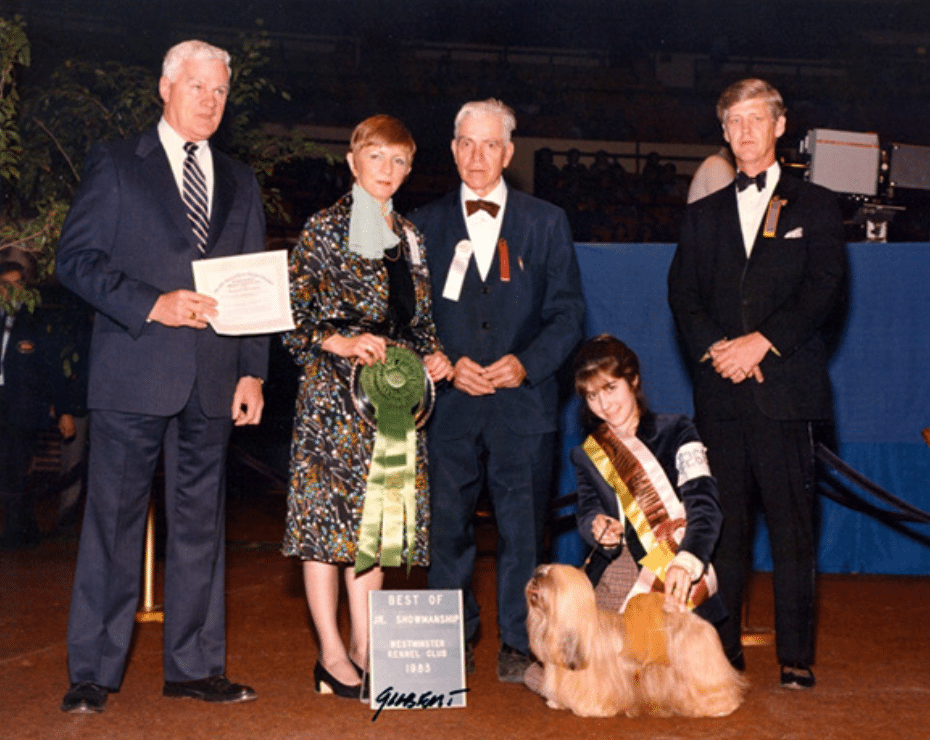JUNIOR SHOWMANSHIP
Where Are They Now
Since 1934, The Westminster Kennel Club has bestowed the title of Best Junior Handler to one deserving recipient. These talented handlers, who are between the ages of 9-18, come from all across the country to be judged on their dog handling skills, with eight advancing to the finals competition. These dedicated dog lovers spend countless hours training, grooming, and perfecting their ring techniques throughout the year to qualify for a chance to show at Westminster. Each year, approximately 100 qualified Juniors make their way to New York City for the most prestigious junior handling competition in the sport. The Westminster Kennel Club congratulates these Juniors for their continued involvement and future success in the sport of showing dogs and beyond.
1983 WESTMINSTER BEST JUNIOR HANDLER
TRACIE LALIBERTE
How did you become involved in showing dogs? My fifth-grade math teacher, Sandy Bologna (Dunn) bred and showed Golden Retrievers, Doberman Pinschers, and Lhasa Apsos under the Tangleloft affix. She and my mom became friendly while my mom was a parent volunteer at my elementary school. One day, my teacher invited me to attend a dog match on the weekend. I had no idea what I was getting into, but I went to the Yankee Golden Retriever specialty match that Sunday. Back then, in late 1970’s, the match was held in someone’s back yard! Everyone parked on the back lawn, the ring was roped off with stakes, lunch was homemade potluck and everyone was welcome to use the bathroom inside the woman’s home. I remember it was a wet, rainy day and I got to show one of the puppies. She was second out of two, no doubt my handling skills, or lack thereof,

sabotaged her. I was 9 years old and that fateful day changed my life forever. As time passed, my mom and Sandy became better friends. I learned about dogs by spending time doing dog-related chores while visiting Sandy’s home and working for her behind the scenes at the shows. That was a time when kids interested in showing began by first mastering the skill of picking up poop and unloading the van before being allowed to hold a show lead! So, I worked hard and I learned. Some time passed, and my mom bought a show quality Doberman from Sandy. Not long after that Sandy sent home a Lhasa, who “refused to pick her tail up,” with my mom to see if she could do anything with her. The Doberman never finished…. but my mom worked miracles with the Lhasa and was able to finish her. Mom and I both got more involved and began breeding and showing our own Lhasas.
Describe what you remember from showing in the Junior Showmanship Finals at WKC. I was very fortunate to show in the finals both times that I competed in Juniors at WKC. I was either 12 or 13 the first time, and I was 17 the year that I won. I remember in 1983 while assessing the ring before we went in, first noticing how different the arena seemed to me from the first time that I showed. I remember thinking that the lighting seemed so much fancier, I no longer noticed any rows of folding chairs lined along the walls on the Garden floor and this time I made note of the soft glow of that amber carpeting. When we all entered, all the noise seemed to hush into windy whispers and I remember that my shoes did not grip well on the carpet because I felt a tiny slip with every step I took. during the first go around. I remember the kindness of so many people who helped me for the pictures, the graciousness of the other Juniors, and the excitement of friends who were there that night. However, what I remember most about that night was the playing of the National Anthem after the Juniors showed. To this day, whenever I hear it, I am transported back and am still moved by those overwhelming feelings of winning such a tremendous honor.
What were you most nervous or excited about showing at The Garden? The Garden is, and always has been such a prestigious event to me. I believe the excitement started when I got my final qualifying win that year. Planning for the dogs, choosing the outfit, getting there, benching, grooming, showing — all of it was simultaneously nerve-wracking and exciting. However, what most people don’t know is that we hadn’t really planned for the chance that I might make the finals. My mom was unable to miss work on Tuesday, and she needed to leave to go back to Massachusetts at the end of benching on Monday. That meant needing to find a place to stay with my dog on Monday night, a way to get to the show on Tuesday AND someone willing to give the kid and dog a ride home Tuesday night. Our “family” in dogs stepped right up to help, and I will be forever grateful to the parents of my dear friend Kim Leach who took me to their home in Cheshire, Ct. for the night, and then returned me to the heart of NYC the next day. Believe it or not, that same 5th grade math teacher who got me involved in showing dogs was the one who drove me and my dog –the very dog that she had sent home with my mother to work with several years before– home to Norton, MA Tuesday night.
How long had you and your dog been showing together before the Garden? When I started in Juniors as a youngster, I mostly showed whatever dog was available to show in our string of dogs at a particular time because the entry fee for Juniors as an add on was much less expensive (often even free) than an entry fee for a dog entered for Juniors only. This meant that I had the chance to show many different dogs in Juniors. Sometimes I showed puppies because it meant extra ring experience for them. Sometimes I showed class dogs who had issues to work through. I showed a Champion here and there, but not very often because it seemed like too much to ask of the dog if he/she won the breed and was being shown in the group. It wasn’t until the last year that I was showing in Juniors that I settled into showing just one dog — my Garden dog. My mom decided that because there always seemed to be a time conflict with breed and Juniors that it surely would be easier if I showed a designated dog in Juniors. She decided the retired champion — the first dog that she had finished — seemed to fit the bill perfectly because she still came everywhere with us, which made her readily available. She became my charge and we were a steady team for all of 1982 and until after the Garden in 1983.
How has winning BJH affected your career? How has it affected your love of showing dogs? BJH at WKC will always and forever be a very important milestone accomplishment to me. To be sure, my love of showing dogs began with that 2nd place Golden puppy in the wet backyard at my first match. Juniors as a competition, however, taught me much about the importance of being skilled as a handler to address the unique and individual needs required for showing each dog as a different entity. Most importantly, the Junior ring taught me about camaraderie, friendship, and sportsmanship.
What did you do after winning BJH? How did you celebrate your win? After winning BJH, I slept the entire ride home! I went to school the next day. My family celebrated with a great dinner out that following weekend. My folks and I still celebrate any good winning this way.
What did you do after aging out of Juniors? Even though I was 17, I did not show in Juniors after winning BJH at WKC. Instead, I continued on my path breeding dogs with my mom and showing in breed. However, I was sponsored by Pedigree Dog food to show in Juniors one last time the following February at Crufts Dog show.
How has the WKC BJH scholarship aided your passion for dogs? What did you go on to study in college? I did not attend college directly following High School, so I regrettably did not take advantage of the $1000 scholarship that I was awarded. Instead, I began running the grooming division of my family’s all-breed boarding kennel. I did begin college when I was 22, attending nights while working full time at the kennel. I presently teach Composition and Literature at a small private College. However, as a Master’s and student and Doctoral candidate in the Humanities, I managed to shape what are otherwise core college studies around dogs in a rather unconventional manner. I’m nearly finished writing a Doctoral Dissertation about the Family dog as a bridge to the Sacred. I’m examining a person’s relationship with their dog as both a technology and as a remedy to the quelling of the human spirit that is a condition of technological proliferation. I also have completed advanced studies and am board certified in Animal Naturopathy.
What is the best advice you could give to Juniors showing at WKC? Have fun, remember to breathe, and be sure to wear non-slip shoes!
How have you made an impact on future generations of the sport? I try to encourage and help any young person who shows an interest in dogs. My life philosophy is to lead by example. I can only hope that my continued involvement with, love for, and willingness to learn teach and share about any aspect of purebred dogs might inspire future generations in the same manner that the greats of the past generation –phenomenal women who I admired so much as a young girl growing up in dogs — such as the late Anne Rogers Clark, Jane Forsyth, Michelle Billings and so, so many others have indelibly shaped me.

